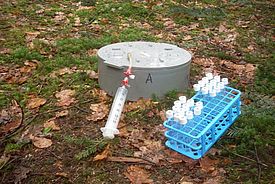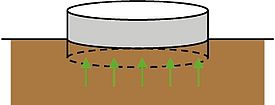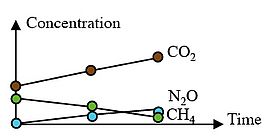Various gases are exchanged between the soil atmosphere and the above-ground atmosphere. Microorganisms and roots release carbon dioxide (CO2) in the soil. The conversion of nitrogen compounds produces nitrous oxide in the soil (N2O). The microorganisms that live in the soil depend on its moisture condition. They produce or consume methane (CH4), whereby soil compaction plays a role, among other factors (Fig. 4).
All gases mentioned above are relevant to the climate, i.e. they contribute to the greenhouse gas effect and thus to global warming.
Gas exchanges are measured in a plastic cylinder. Before the gas samples are collected, the cylinder is covered with a lid. The air in the cylinder is then sampled three times at defined time intervals. The change in the concentration of the gases is an indicator of the gas exchange between the soil and the atmosphere.
Aims of measurements:
- to show the development of gas fluxes during the year and the variations between different locations.
- to quantify the contribution of these gases to the biogeochemical cycle of carbon and nitrogen.
- to demonstrate the relevance of forest soils as a source or sink of greenhouse gases.



